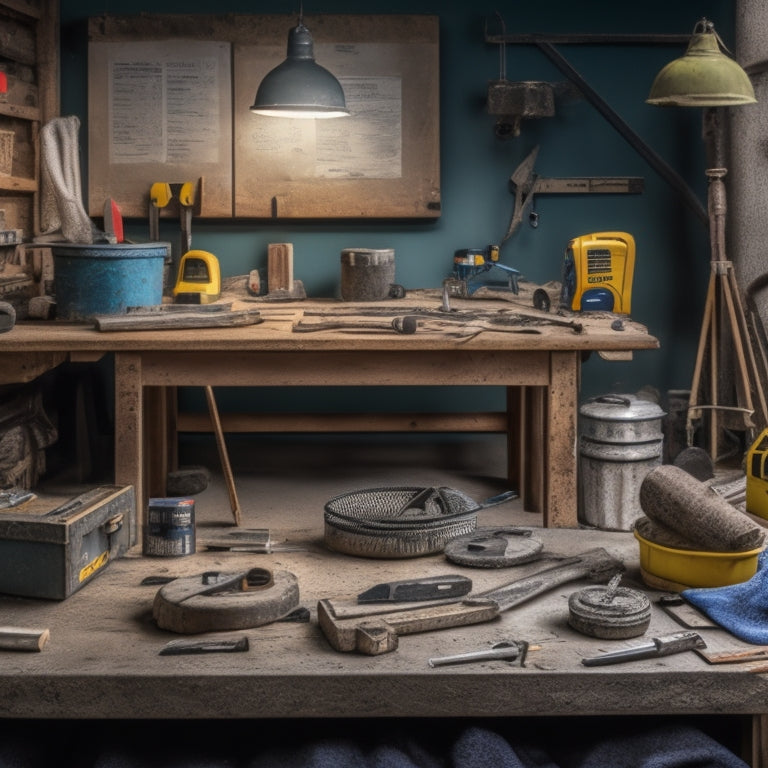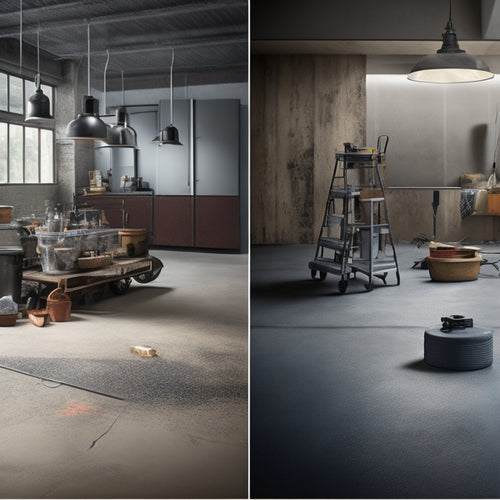
What Measuring Tools Do Concrete Finishers Need
Share
You'll need a range of measuring tools to guarantee accuracy and precision in your concrete finishing projects. For length measurements, use taping measures, laser distance measurers, and measuring wheels. To measure angles, rely on digital angle finders and protractors. Levels and straightedges help you achieve precision in surface preparation and finishing. String lines are essential for alignments, while depth gauges measure the thickness of freshly poured concrete. With these tools in your kit, you'll be well-equipped to tackle any project - and understanding how to use them effectively is just the starting point.
Key Takeaways
• Concrete finishers need length measurement tools like taping measures, laser distance measurers, and measuring wheels for accurate pours and layouts.
• Angle measurement tools such as digital angle finders and protractors are essential for measuring angles in stairs, ramps, and complex structures.
• Surface preparation and finishing tools like levels, straightedges, chalk lines, and string lines help achieve sharp, defined lines and joints in concrete.
• Thickness measurement tools, including depth gauges, are necessary for measuring the thickness of concrete accurately.
• Regular checks and calibration of all measuring tools are crucial to maintain accuracy and ensure high-quality results in concrete finishing projects.
Taping Measures for Precise Lengths
You'll likely reach for a taping measure daily to verify lengths and widths on the job site. As a concrete finisher, accurate measurements are vital to guarantee precise pours, proper layouts, and quality finishes. To get the most out of your taping measure, it's important to master tape measure techniques that assure measuring tape accuracy.
First, always hold the tape measure level and plumb to prevent skewed readings.
Next, use the hook on the end of the tape to anchor it to a fixed point, allowing you to take precise measurements without assistance.
When measuring long distances, use a second person to hold the tape's midpoint, reducing sag and guaranteeing accuracy.
Additionally, regularly check your tape measure for damage or wear, as a worn or kinked tape can lead to inaccurate readings.
By following these techniques, you'll confirm that your measurements are precise, saving you time and reducing errors on the job site.
With a reliable taping measure and the right techniques, you'll be able to take precise lengths and widths, every time.
Levels for Accurate Plumbness
When you're working on a concrete project, you need to verify that your walls, columns, and other structures are perfectly vertical and straight.
You'll use levels to check for any deviations from plumbness, assuring that your work is accurate and professional.
Check for Deviations
Check for deviations from plumbness by using a level to guarantee the concrete finish is accurately vertical.
You don't want any sloping or leaning surfaces, as they can compromise the structural integrity of the building. To perform a deviation analysis, place your level on the surface and check the bubble vial. If the bubble is centered, the surface is plumb. If it's not, you need to make adjustments.
When checking for deviations, it's crucial to also evaluate the surface flatness.
You can use a long spirit level or a laser level to scan the surface and identify any high or low spots. This will help you identify areas that need correction to guarantee the surface is flat and even.
Ensure Perfect Verticality
By the time you start finishing a concrete surface, it's essential to verify perfect verticality using levels that guarantee accurate plumbness. You can't afford to compromise on vertical alignment techniques, as even the slightest deviation can affect the entire structure's integrity. To guarantee perfect verticality, you'll need reliable levels that can detect even the slightest tilt or inclination.
Opt for high-quality spirit levels or laser levels that can provide accurate readings. These tools will help you achieve concrete finishing standards that meet the industry's requirements.
When using spirit levels, make sure to check the vial's accuracy and cleanliness to avoid false readings. For laser levels, follow the manufacturer's instructions for calibration and operation.
Verify Straight Lines
To guarantee your concrete surface is perfectly aligned, you need to verify straight lines using levels that can detect even the slightest deviation from true plumbness. This is essential for achieving line accuracy, as even minor errors can lead to costly rework or compromise the structural integrity of the finished product.
When verifying straight lines, you'll want to use a level that provides precise readings and allows for quick visual alignment. Look for a level with a high-resolution display and a robust magnetic attachment system, ensuring it stays put on metal surfaces.
This will enable you to make precise adjustments on the fly, ensuring your concrete surface meets the required specifications.
Laser Distance Measers
You'll find laser distance measurers to be a game-changer on the jobsite, providing accurate distance calculations in a fraction of the time it takes with traditional tape measures.
With laser accuracy benefits, you can guarantee precise measurements, reducing errors and rework. Laser distance measurers use advanced distance measurement techniques, such as phase shift and time-of-flight, to provide accurate readings up to 100 meters.
Here are three key benefits of using laser distance measurers:
-
Speed: Laser distance measurers can calculate distances up to 10 times faster than traditional tape measures, saving you time and increasing productivity.
-
Accuracy: Laser distance measurers provide precise measurements, reducing errors and guaranteeing that your concrete finishing projects are accurate and precise.
-
Convenience: Laser distance measurers are often compact and lightweight, making them easy to use and transport on the jobsite.
Digital Angle Finders
Accurate measurements aren't the only vital aspect of concrete finishing; precise angles are also important, and that's where digital angle finders come in. These tools are a game-changer when it comes to guaranteeing accurate digital angle applications. With digital angle finders, you can measure angles with precision, whether you're working on stairs, ramps, or complex concrete structures.
Here's a breakdown of what you can expect from a digital angle finder:
| Feature | Description | Benefits |
|---|---|---|
| Digital Angle Accuracy | Measures angles with ±0.1° accuracy | Guarantees precise angle measurements |
| Backlit LCD Display | Clearly displays measurements in various units | Easy to read in low-light conditions |
| Compact Design | Fits comfortably in your pocket or toolbox | Convenient to carry around |
As a concrete finisher, you know how important it is to get the angles right. With a digital angle finder, you can achieve digital angle accuracy like never before. Whether you're a seasoned pro or just starting out, this tool is an essential addition to your arsenal. By incorporating a digital angle finder into your workflow, you'll be able to deliver high-quality results with confidence.
Straightedges for Clean Edges
When working with concrete, achieving clean edges requires a reliable straightedge that helps you create sharp, defined lines and joints. A straightedge is a fundamental tool for edge finishing, allowing you to create precise edges and joints that meet your project's specifications. To guarantee accurate results, it's crucial to choose a straightedge that's durable, accurate, and easy to use.
Here are three key considerations for selecting and maintaining a straightedge:
-
Material selection: Choose a straightedge made from a durable material, such as aluminum or fiberglass, that can withstand the rigors of concrete finishing.
-
Accuracy verification: Regularly check your straightedge for accuracy to make sure it remains true and straight.
-
Tool maintenance: Clean and store your straightedge properly to prevent damage and make certain it remains in good condition.
Chalk Lines for Snap Lines
When you're working on a concrete project, you need to lay out straight lines accurately and efficiently.
That's where chalk lines for snap lines come in - they help you create precise reference points and mark concrete surfaces with ease.
Laying Out Straight Lines
You'll rely on chalk lines to snap straight lines, an essential step in laying out a concrete project that demands precision and accuracy. When it comes to laying out straight lines, you can't afford to make mistakes. Chalk lines allow you to mark precise lines on the surface, guaranteeing your project stays on track.
Here are three key considerations for effective line marking:
-
Surface preparation: Make sure the surface is clean, dry, and free of debris to guarantee the chalk line adheres properly.
-
Line placement: Carefully plan and mark the location of your lines, taking into account the project's specifications and requirements.
-
Snap line accuracy: Double-check your snap lines to guarantee they're straight, level, and accurately positioned.
Creating Accurate Reference Points
By creating accurate reference points with chalk lines, you establish a reliable foundation for snapping precise lines and guaranteeing your concrete project stays on track. To achieve this, you'll need to master reference point techniques that assure straight lines and correct alignment.
Start by identifying key points on your concrete surface, such as corners, edges, or center points. Use a chalk line reel to snap a line between these points, creating a visual guide for your work.
To guarantee accuracy, employ alignment strategies like using a level or a laser level to ensure your lines are straight and plumb. You can also use a string line to create a temporary guide, allowing you to check your work and make adjustments as needed.
Marking Concrete Surfaces Easily
With a network of accurate reference points established, snap a chalk line to create a precise mark on your concrete surface, ensuring a clear visual guide for your finishing work.
This vital step in concrete surface preparation allows you to accurately visualize and execute your design. When it comes to marking concrete surfaces easily, chalk lines are an essential tool in your arsenal.
Here are three key benefits of using chalk lines for snap lines:
-
Accurate marking: Chalk lines provide a precise and consistent mark, ensuring your finishing work is accurate and professional.
-
Easy to use: Simply stretch the line between two points, snap it, and apply marking paint for a clear, visible mark.
-
Temporary and removable: Chalk lines are easy to remove, leaving no residue or damage to your concrete surface.
String Lines for Alignments
String lines serve as a visual guide, helping concrete finishers achieve precise alignments and maintain even surfaces throughout the project. By installing string lines, you'll guarantee that your concrete pours are accurate and even. Proper string line installation is vital to achieving this goal. Here are some key considerations:
| Step | Description | Tips |
|---|---|---|
| Installation | Set up string lines along the concrete formwork, making sure they're level and secure. | Use sturdy stakes and tight knots to prevent shifting. |
| Maintenance | Regularly check and adjust string lines to confirm they're still level and secure. | Perform checks after each concrete pour to account for any shifts. |
| Removal | Remove string lines carefully to avoid damaging the concrete surface. | Use a gentle pulling motion to avoid leaving marks. |
In addition to proper installation and maintenance, it's important to regularly inspect your string lines for wear and damage. Replace them as needed to guarantee accurate alignments and a high-quality finish. By following these best practices, you'll be able to achieve precise alignments and maintain even surfaces throughout your concrete project.
Measuring Wheels for Distance
You'll need a reliable way to measure distances accurately, and that's where measuring wheels come in, providing a quick and efficient method for calculating distances, widths, and lengths on your concrete project.
With a measuring wheel, you can measure large areas quickly and accurately, making it an essential tool for concrete finishers.
When it comes to measuring wheel types, you have several options to choose from, each with its own unique features and benefits. Here are three common distance measurement techniques to evaluate:
-
Basic Measuring Wheels: These wheels are simple, affordable, and easy to use. They're perfect for small to medium-sized projects and provide accurate measurements up to a certain distance.
-
Digital Measuring Wheels: These wheels offer advanced features like digital displays, memory functions, and unit conversion. They're ideal for larger projects that require precise measurements and calculations.
-
High-Accuracy Measuring Wheels: These wheels are designed for precision and accuracy, often used in high-stakes projects that require exact measurements. They're typically more expensive but provide unparalleled accuracy.
Protractors for Angle Measurements
When you're working on a concrete project, you'll often need to measure angles accurately to guarantee a professional finish.
You'll use a protractor to do this, and it's essential you can read the scale correctly to get the right measurement.
Measuring Angles Accurately
Accurate angle measurements are essential in concrete finishing, and a protractor is the go-to tool for guaranteeing precise readings. As a concrete finisher, you need to master angle measurement techniques to guarantee that your work meets the required standards.
A protractor helps you measure angles accurately, which is critical in concrete finishing applications such as laying floors, installing countertops, and constructing walls.
Here are three key angle calculation methods you should know:
-
Measuring angles from a reference line: Use a protractor to measure the angle between a reference line and a surface or an edge.
-
Measuring angles between two surfaces: Measure the angle between two surfaces, such as the angle between a floor and a wall.
-
Measuring angles of irregular shapes: Measure the angle of an irregular shape, such as a curved surface or an irregularly shaped wall.
Reading Protractor Scales
Mastering the art of reading protractor scales is crucial for concrete finishers, as it enables them to take precise angle measurements, guaranteeing their work meets the required standards. You'll need to be familiar with the different types of protractors, including digital, bevel, and combination protractors. Each type has its own unique features and uses, and understanding these differences will help you choose the right tool for the job.
Here's a breakdown of three common protractor types and their uses:
| Protractor Type | Description | Best For |
|---|---|---|
| Digital Protractor | Electronic device that displays angle measurements in degrees | Precise measurements in tight spaces |
| Bevel Protractor | Adjustable protractor with a rotating bezel | Measuring and marking precise angles |
| Combination Protractor | Combines a protractor with a square and other measuring tools | Measuring angles and checking squareness |
When taking angle measurements, it's important to use the correct angle measurement techniques. Make sure to hold the protractor level and steady, and take multiple readings to guarantee accuracy. By mastering the art of reading protractor scales, you'll be able to take precise angle measurements and ensure your work meets the highest standards.
Depth Gauges for Thickness Checks
You use depth gauges to measure the thickness of freshly poured concrete, making certain it meets the specified requirements. This vital step guarantees the structural integrity and quality of the finished product.
There are various depth gauge types, each suited for specific thickness measurement techniques.
Here are three essential considerations for choosing the right depth gauge:
-
Digital vs. Analog: Digital depth gauges provide precise, error-free readings, while analog gauges require more skill and attention to detail.
-
Probe Length and Material: Select a depth gauge with a probe long enough to reach the bottom of the concrete slab, and made from a durable material that can withstand harsh environments.
-
Accuracy and Resolution: Opt for a depth gauge with high accuracy (±1/16 inch or better) and resolution (0.01 inch or better) to make certain reliable thickness measurements.
Frequently Asked Questions
Can Concrete Finishers Use Smartphones as Alternative Measuring Tools?
Can you use your smartphone as an alternative measuring tool on the job site? Yes, you can!
With advanced smartphone applications, you can take advantage of digital measuring capabilities. Many apps offer accurate measurements, and some even use augmented reality to help you visualize the project.
However, keep in mind that smartphones may not be as precise as dedicated measuring tools, so use them as a supplement, not a replacement, for critical measurements.
How Often Should Measuring Tools Be Calibrated for Accuracy?
You're standing on the construction site, surrounded by the hum of machinery and the aroma of freshly poured concrete. But amidst the chaos, precision is key.
When it comes to measuring tools, you can't afford to be off by a hair's breadth. That's why calibration frequency is essential.
For peak accuracy, you should calibrate your tools every 3-6 months, or according to the manufacturer's guidelines. This guarantees you're meeting accuracy standards, and your work is nothing short of exceptional.
Are Measuring Tools Specific to Certain Types of Concrete Projects?
When you're working on a concrete project, you'll find that measuring tools aren't one-size-fits-all.
You'll need to choose tools that fit your project's specifications, whether it's a residential patio or a commercial high-rise.
Different measuring techniques are required for different types of projects, and you'll need to select tools that can handle the specific demands of your job.
Can Measuring Tools Be Shared Among Multiple Workers on a Site?
When you're working on a site, you're likely wondering if you can share measuring tools among multiple workers. The answer is, it depends.
While tool sharing can boost site efficiency, it's essential to take into account the type of tool and the workers' needs.
For instance, a laser level can be shared, but a specialized tool like a slump cone might be better assigned to a single worker.
You'll need to strike a balance between tool sharing and individual needs to maximize productivity.
Do Measuring Tools Require Special Storage or Maintenance?
You'll want to confirm your measuring tools are stored properly to maintain their accuracy.
Check the manufacturer's guidelines for ideal storage conditions, such as temperature and humidity ranges.
Regularly clean and dry your tools to prevent damage.
Establish maintenance practices like calibrating your tools regularly and replacing worn-out parts.
Conclusion
You've got the right skills and the right team, but without the right measuring tools, your concrete finishing project can quickly go off the rails.
Don't assume that 'close enough' is, well, close enough - precision matters.
Having the right tools guarantees accuracy, efficiency, and a professional finish.
So, don't skimp on the essentials; invest in the measuring tools that'll help you deliver excellent results and avoid costly mistakes.
Related Posts
-

7 Tools to Fix Damaged Concrete Floors
You're about to tackle that damaged concrete floor, and the right tools are essential for a successful repair. Start ...
-

Must-Have Handheld Tools for Concrete Repair
When tackling a concrete repair project, it is crucial to have the right handheld tools to achieve a professional fin...
-

Top Tools for Revamping Old Concrete Floors
You'll need a range of tools to revamp your old concrete floor, starting with epoxy, acrylic, or polyurethane paint, ...


